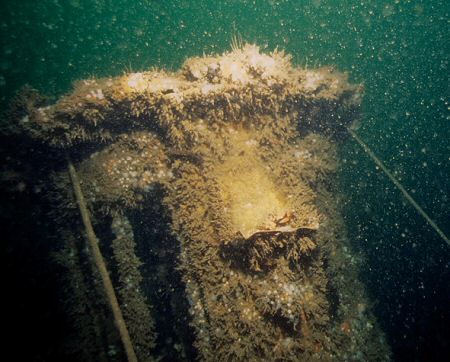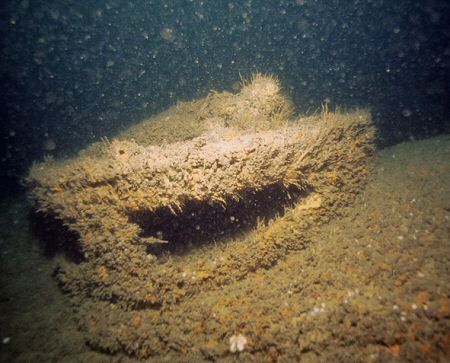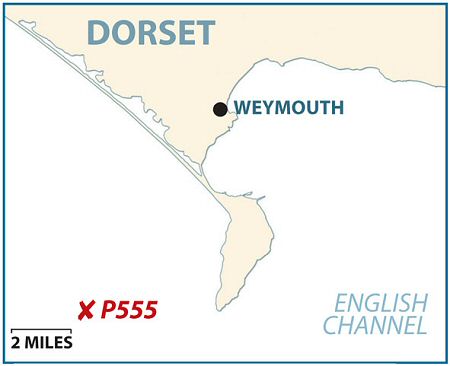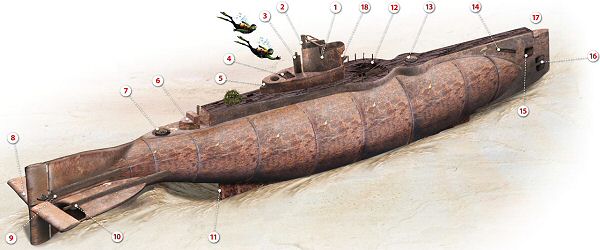Our July Wreck Tour of the U-boat U480 went down well, if you’ll pardon the pun, so this month JOHN LIDDIARD offers a double helping of submarines, with the P555 off Portland. Illustration by MAX ELLIS
KNOWING THAT SUBMARINES are notoriously troublesome to shot, skipper Rod Thompson takes a few tries before he is happy that the shot is hooked solidly across the conning tower of the P555 (1), about 36m down and 9m above the 45m seabed.
The bay at the front of the conning tower is the surface bridge, from where the captain would have commanded the submarine while surfaced. At the back of the conning tower is the first and smaller of two periscope housings (2), with a second larger one (3) standing from the deck behind the tower.

Both periscopes were removed before P555 was sunk as a sonar target. Immediately aft of the second periscope housing is a small square hatch in the deck (4). Beneath this would be a round hatch for the pressure and watertight opening into the hull.
The raised section of deck around the conning tower comes to a tapered end, with a notch cut out where the navigation light would have been fitted (5).

Considering that the P555 has been down since 1947, the wooden decking is in remarkably good condition, though in a few places it’s rotting through. The general depth of the deck is just short of 40m.
The raised section of deck ends with a notch across it (6) just before it tapers away. I have been unable to discover the purpose of this notch.
Aft of this, a circular hatch (7) is level with the top of the pressure hull. P555 had no aft torpedo tube, so there was no reason for a sloping hatch to facilitate loading of torpedoes. It is purely for crew access.

The hull now tapers away to a set of fins in a cruciform arrangement (8), with an upright rudder and horizontal hydroplane.
Close in beside the fin, control rods (9) lead aft from the hull to lever and gear mechanisms to move the rudder and hydroplane.
Further out, twin propeller-shafts (10) end at cut-outs immediately forward of the hydroplane, though the propellers were clearly removed before P555 was sunk.
Below the stern, the general seabed depth of 45m drops into a scour at 47m behind the keel (11). For most divers there is little point in making this deeper diversion, so keeping our tour above 45m.
Back on the deck, forward of the conning tower a wider area (12) marks where the gun would have been fitted. There are still a few uprights from the railing about the gun position, though again the gun would have been removed before P555 was sunk.
Continuing forward, the narrow deck again widens to accommodate the forward hatch (13). The deck continues all the way forward to the bow.
Just below the deck, where the hull begins to taper away, a sloped socket (14) is the fitting for the bow hydroplane.
At a similar level, a small anchor (15) is tightly recessed into the hull. Now at the bow, the entrances to the four torpedo-tubes are visible, two on each side (16).
A slight step in the bow (17) marks where a hydrophone transducer would have been fitted.
Our quick tour of this small sub ends back at the conning tower, where a recess at the front marks the point at which another navigation light would have been fitted (18).
For a short decompression, the shotline should be easy enough to relocate and ascend. For a longer decompression the tide will build quickly, so a deco station or DSMB is essential.
PACIFIC TO PORTLAND
P555, submarine. BUILT 1922, SUNK 1947
HER AMERICAN CREWS called their sub “State Express 555”, after the popular cigarette brand and her building pennant number P555, writes Kendall McDonald.
The 854-ton S-class boat was launched as S24 on 27 June, 1922, at the Fore River Shipbuilding Yard, Bethlehem, USA.
She had a crew of 42, was 216ft long, had a beam of 20ft and drew 14ft. She carried twelve 21in torpedoes for her four bow tubes, and had a 4in deck gun.
Her twin 600hp eight-cylinder diesels gave her a top speed of 13 knots and a range of 8000 miles at 10 knots.
From 1923, she ranged the Pacific world. On 11 September, 1938, she was struck off the US Navy List, and in October 1942 was transferred under Lease Lend and commissioned as submarine P555 of the Royal Navy.
Slightly damaged in a collision in the Clyde, P555 was paid off for return to the US Navy, but it then once again struck her off its active list.
On 25 August, 1947, P555 was intentionally sunk as an ASDIC target some 3.8 miles west of Portland Bill. She is intact except for her deck gun and propellers, removed before the sinking.

TOUR GUIDE
GETTING THERE: Follow the A37 or A354 to Dorchester, then the A354 to Weymouth, continuing along the back of the harbour. Turn left just before the fire station. Out-Rage is berthed at Weymouth Quay, by the Sailor’s Return pub, across the bridge. Arrive early, as you may have to wait for space to unload before parking and walking back to the boat.
HOW TO FIND IT: GPS co-ordinates are 50 30.913N, 002 33.466W (degrees, minutes and decimals). The wreck lies bow to the east on a flat seabed, so shows well on an echo-sounder.
TIDES: Slack is between 3.5 and 4 hours after high water Portland.
DIVING & AIR: Out-Rage, skipper Rod Thompson, 01305 822803
ACCOMMODATION: B&Bs, small hotels and hostels. Out-of-town campsites are usually smart and a bit expensive. Weymouth Tourist Information 01305 785747.
QUALIFICATIONS: Best for those with technical qualifications such as Advanced Nitrox or Decompression Procedures.
LAUNCHING: Closest slip is at Castletown in Portland.
FURTHER INFORMATION: Admiralty Chart 2610, Bill of Portland to Anvil Point. Ordnance Survey Map 194, Dorchester, Weymouth & Surrounding Area. Dive Dorset, by John & Vicki Hinchcliffe.
PROS: Compact, easy to navigate and see all of the wreck without getting far into deco.
CONS: Close to Portland Bill, so there is a short and tricky slack.
DEPTH: 35-45m
Appeared in DIVER October 2010

